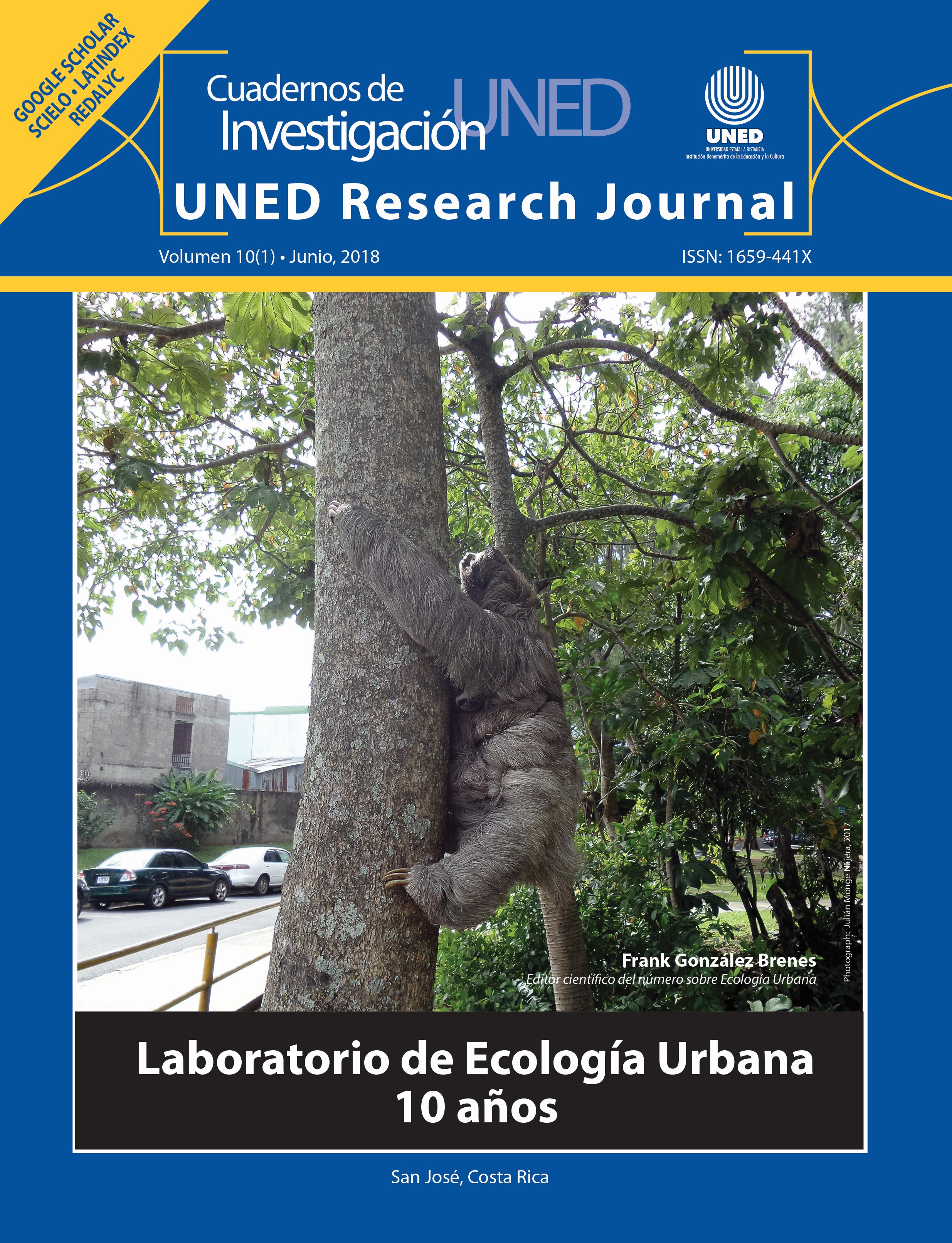Gusanos de ciudad (Onychophora): ¿por qué invertebrados frágiles de un linaje antiguo viven en áreas fuertemente urbanizadas?
DOI:
https://doi.org/10.22458/urj.v10i1.2045Palabras clave:
Fauna urbana, efectos de la urbanización, fósiles vivientes, OnychophoraResumen
Los gusanos de terciopelo, invertebrados frágiles de un linaje antiguo, son muy susceptibles a la extinción por sus pequeñas poblaciones, escasa movilidad y pequeños ámbitos geográficos. Sin embargo, entontré que 19 especies (la mayoría peripátidos de América Latina y el Caribe) han aparecido en hábitats fuertemente urbanizados. Los onicóforos tienen pocas características de los animales urbanos exitosos, pero propongo que sobreviven en ciudades gracias a su dieta y a que son poco conspicuos. La "ciencia ciudadana" podría ayudar a conocer más de los onicóforos urbanosCitas
Barquero-González, J. P., Cabrera Alvarado, A. A., Valle-Cubero, S., Monge-Nájera, J., & Morera-Brenes, B. (2016). The geographic distribution of Costa Rican velvet worms (Onychophora: Peripatidae). Revista de Biología Tropical, 64(4), 1401-1414. doi:10.15517/rbt.v64i4.19486
Barrett, D., Recio, M. R., Barratt, B. I., Seddon, P. J., & van Heezik, Y. (2016). Resource selection by an ancient taxon (Onychophora) in a modern urban landscape: A multi-scale analysis approach to assist in the conservation of an animal phylum. Landscape and Urban Planning, 148, 27-36.
Cupul-Magaña, F. G., & Navarrete-Heredia, J. (2008). Rediscovery and new data for Oroperipatus eisenii (Wheeler, 1898) from Mexico (Onychophora: Peripatidae). Entomological News, 119(5), 545-549.
Harris, A. C. (1991). A large aggregation of Peripatoides novaezealandiae (Hutton, 1876)(Onycophora: Peripatopsidae). Journal of the Royal Society of New Zealand, 21(4), 405-406.
McIntyre, N. E. (2000). Ecology of urban arthropods: a review and a call to action. Annals of the Entomological Society of America, 93(4), 825-835.
McNeilly, H. 2015. Killer worm and fault line overcome in $45 million Dunedin highway project. Stuff (New Zealand), 20 November: http://www.stuff.co.nz/national/74398223/killer-worm-and-fault-line-overcome-in-45-million-dunedin-highway-project.
Møller, A. P. (2009). Successful city dwellers: a comparative study of the ecological characteristics of urban birds in the Western Palearctic. Oecologia, 159(4), 849-858.
Monge-Nájera, J. & B. Morera-Brenes (2015). Velvet Worms (Onychophora) in Folklore and Art: Geographic Pattern, Types of Cultural Reference and Public Perception. British Journal of Education, Society & Behavioural Science 10(3): 1-9, 2015.
Monge-Nájera, J. (1994). Reproductive trends, habitat type and body characteristics in velvet worms (Onychophora). Revista de Biologia Tropical,42(3), 611-622.
Monge-Nájera, J. (1995). Phylogeny, biogeography and reproductive trends in the Onychophora. Zoological Journal of the Linnean Society, 114, 21–60.
Monge-Nájera, J. (2017). The power of short lectures to improve support for biodiversity conservation of unpopular organisms: an experiment with worms. UNED Research Journal, 9(1), 145-150.
Monge-Nájera, J., & Lourenço, W. R. (1995). Biogeographic implications of evolutionary trends in onychophorans and scorpions. Biogeographica-Paris,71, 179-186. doi:10.1111/j.1096-3642.1995.tb00111.x
Monge-Nájera, J., & Morera-Brenes, B. (2016). Velvet worms (Onychophora) in folklore and art: geographic pattern, types of cultural reference and public perception. British Journal of Education, Society & Behavioural Science, 10(3), 1-9 doi:10.9734/BJESBS/2015/18945
Monge-Nájera, J., Barrientos, Z., & Aguilar, F. (1993). Behavior of Epiperipatus biolleyi (Onychophora: Peripatidae) under laboratory conditions. Revista de Biología Tropical, 41(3 A), 689-696
Newlands G., Ruhberg H. (1978) Onychophora. In: Werger M.J.A. (eds) Biogeography and Ecology of Southern Africa. Monographiae Biologicae, vol 31. Springer, Dordrecht
Oliveira, I. de Sena, Read, V. M. S. J., & Mayer, G. (2012). A world checklist of Onychophora (velvet worms), with notes on nomenclature and status of names. ZooKeys, 211, 1. doi: 10.3897/zookeys.211.3463
Peck, S. B. (1975). A review of the New World Onychophora, with the description of a new cavernicolous genus and species from Jamaica. Psyche, 82(3-4), 341-358. doi:10.1155/1975/98614
Read, V.M.St.J. (1985). The ecology of Macroperipatus torquatus (Kennel) with special reference to feeding and a taxonomic review. Ph.D. Thesis, University College of North Wales, Bangor.
Runge, C. A., Tulloch, A., Hammill, E., Possingham, H. P., & Fuller, R. A. (2015). Geographic range size and extinction risk assessment in nomadic species. Conservation Biology, 29(3), 865-876.
Sampaio-Costa, C., Chagas-Junior, A., & Baptista, R. L. (2009). Brazilian species of Onychophora with notes on their taxonomy and distribution. Zoologia (Curitiba), 26(3), 553-561. doi:10.1590/S1984-46702009005000004
Shochat, E., Warren, P. S., Faeth, S. H., McIntyre, N. E., & Hope, D. (2006). From patterns to emerging processes in mechanistic urban ecology. Trends in ecology & evolution, 21(4), 186-191.
Sol, D., Lapiedra, O., & González-Lagos, C. (2013). Behavioural adjustments for a life in the city. Animal Behaviour, 85(5), 1101-1112.
Xocoyotzin Toledo-Matus, X.; G. Rivera-Velázquez; J. Monge-Nájera & B. Morera-Brenes (2018). An undescribed species of velvet worm from Chiapas, Mexico (Onychophora: Peripatidae). UNED Research Journal, 10(1), in press.
Descargas
Archivos adicionales
Publicado
Cómo citar
Número
Sección
Licencia
Nota: Este resumen contiene un copyright incorrecto debido a problemas técnicos. Los autores que publican en esta revista aceptan los siguientes términos: Los autores conservan los derechos de autor y otorgan a la revista el derecho de primera publicación, con la obra simultáneamente bajo una Licencia de Atribución de Creative Commons que permite a otros compartir la obra con el reconocimiento de la autoría y la publicación inicial en esta revista.
Los contenidos se pueden reproducir citando la fuente según la licencia de Acceso Abierto CC BY 4.0. El almacenamiento automático en repositorios está permitido para todas las versiones. Incentivamos a los autores a publicar los datos originales y bitácoras en repositorios públicos, y a incluir los enlaces en todos los borradores para que los revisores y lectores puedan consultarlos en cualquier momento.
La revista está financiada con fondos públicos a través de la Universidad Estatal a Distancia. La independencia editorial y el cumplimiento ético están garantizados por la Comisión de Editores y Directores de Revistas de la UNED. No publicamos pautas publicitarias pagadas ni recibimos financiamiento de la empresa privada.
